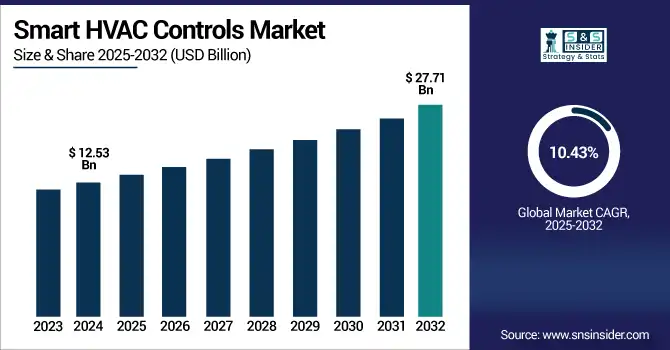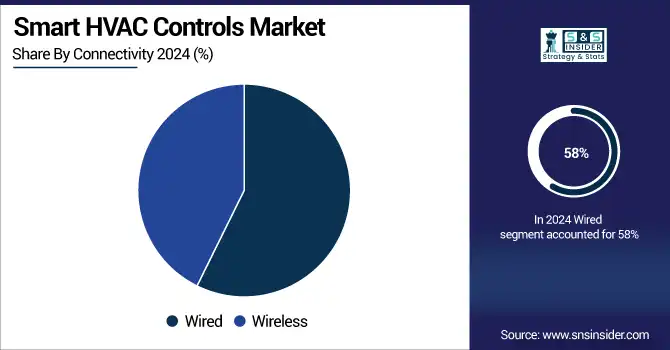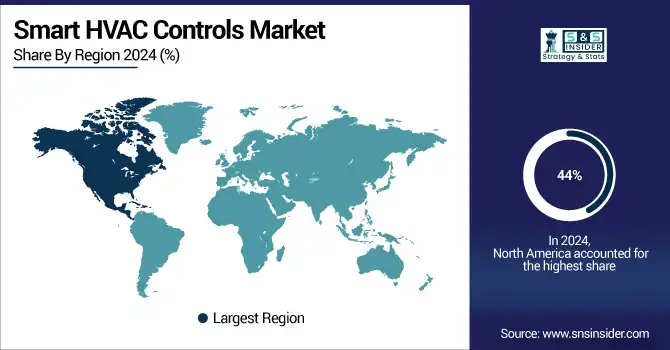Smart HVAC Controls Market Size & Trends:
The Smart HVAC Controls Market size was valued at USD 12.53 Billion in 2024 and is projected to reach USD 27.71 Billion by 2032, growing at a CAGR of 10.43% during 2025-2032.

To Get more information on Smart HVAC Controls Market - Request Free Sample Report
Increasing need for energy-efficient, connected, and intelligent climate management solution across residential, commercial, and industrial sectors is expected to drive the Smart HVAC Controls market growth strongly over the forecast period. Similarly, as we move toward more intelligent buildings, and with more stringent energy and emissions regulations, manufacturers are also embedding AI, IoT and predictive maintenance elements within HVAC systems. Real-time system optimization, energy draw reduction, operational cost minimization, and overall equipment efficiencies and life extension enabled by these sophisticated technologies make smart HVAC controls a significant driver of future-ready and sustainable infrastructure.
High-efficiency HVAC systems powered by Renesas' 10.5kW motor control with RA6T2 MCU and Reality AI. It integrates predictive maintenance and real-time optimization to improve both performance and sustainability.
The U.S Smart HVAC Controls Market size was valued at USD 3.76 Billion in 2024 and is projected to reach USD 6.85 Billion by 2032, growing at a CAGR of 7.76% during 2025-2032. This Smart HVAC Controls Market growth is fueled by rising demand for energy-efficient climate systems, increasing integration of IoT and AI technologies, and the expanding adoption of smart building solutions across residential, commercial, and industrial applications.
Smart HVAC Controls Market Dynamics:
Drivers:
-
Rising Demand for Energy-Efficient Heating Drives Smart HVAC Market Expansion
Rising inclination towards reduction in greenhouse gas emissions and increase in energy efficiency is one of the major factors driving the smart HVAC systems market growth. With the tightening of energy standards by the regulators and the elimination of fossil-fuel-based heating coming, air-to-water heat pump (AWHP) and smart hot water storage technologies are becoming increasingly popular. Utilizing ambient air for heating and cooling, these systems provide a more sustainable solution, cutting carbon footprints while improving indoor comfort. Additionally, the increased demand for integrated and AI based HVAC systems for real-time optimization and predictive maintenance is expected to expand the market further. The smart HVAC market will grow at an accelerated rate in the coming years, as more capital is directed towards sustainable infrastructure and smart buildings, both in the residential and commercial sectors.
LG Electronics has taken over Norway’s OSO Group AS, a move that will boost its holding in the heating, ventilation and air-conditioning (HVAC) market in Europe. The agreement marries LG's AWHP systems with OSO's intelligent hot water storage technology to satisfy rising energy efficiency requirements.
Restraints:
-
Limited Infrastructure and Affordability Slows Smart HVAC Adoption in Emerging Markets
The adoption of smart HVAC controls is hindered by inadequate digital infrastructure, high upfront costs, and low consumer awareness. These markets often lack widespread access to reliable internet connectivity and smart grid systems, which are essential for operating intelligent HVAC technologies. Additionally, the cost of smart equipment and installation remains out of reach for many end-users, especially in residential sectors. Limited government incentives and slow technological diffusion further compound the issue. As a result, despite the global momentum toward energy-efficient systems, the penetration of smart HVAC controls in emerging economies remains significantly lower compared to developed regions, posing a restraint on the overall growth of the market.
Opportunities:
-
Experience-Driven Engagement Unlocks Growth Opportunities for Smart HVAC Controls Market Trends
This increase in need for smart, energy-efficient building solutions is offering smart HVAC controls an opportunity that is too good to miss. Smart HVAC systems with real-time monitoring, AI-driven automation, enhanced indoor air quality management, and increased energy efficiency have been gaining momentum in the wave of demand for sustainable indoor environment. This has resulted in the systems being attractive to a diverse market of end-users from residential, commercial, and industrial sectors for increased comfort, comfort, and efficiency. Growing focus on customer engagement, system customization & personalization, and wellness-centric technologies are driving manufacturers to provide more interactive & user-friendly products. A growing range of smart infrastructure and green building initiatives have been maturing over the last few years, with growth accelerating in both developed and emerging markets.
In July 2025, Coolwell has launched a first of its kind immersive HVAC Experience Center in Dubai showcasing Daikin’s smart and energy-efficient technologies besides demonstrating Artificial Intelligence and AI in their HVAC operation in July 2025.
Challenges:
-
Technical Complexity and Standardization Gaps Challenge Smart HVAC Controls Market Growth
Despite strong growth prospects, the smart HVAC controls market faces several critical challenges. One of the primary hurdles is the technical complexity involved in integrating smart controls with existing HVAC infrastructure, particularly in older buildings. Compatibility issues and lack of standardized communication protocols across different devices and manufacturers often lead to system inefficiencies and increased deployment costs. Additionally, concerns around cybersecurity and data privacy pose barriers to adoption, especially in sectors handling sensitive information. Another challenge is the limited availability of skilled professionals to install, configure, and maintain these advanced systems. In developing regions, low awareness and inadequate digital infrastructure further hinder widespread adoption. Addressing these challenges is essential to ensure scalable, secure, and seamless deployment of smart HVAC technologies globally.
Smart HVAC Controls Market Segmentation Analysis:
By Component
The Controllers segment held a dominant Smart HVAC Controls Market share of around 46% in 2024, due to the need for system automation, energy efficiency, and centralization of climatic control logic. Rapid growth in demand from commercial and residential buildings and development of programmable and AI-driven controllers are the reasons driving the growth. The North America dominated the market segment and continues its dominance on the segment for the period as the segment can optimize HVAC operation and maximize the comfort of uses.
The Smart Vents segment is expected to experience the fastest growth in the Smart HVAC Controls Market over 2025-2032 with a CAGR of 11.42%, due to increasing demand for optimizing airflow, customized conditions and energy savings at room-level, especially in residential. However, smart vent adoption is further fueled by factors such as integration with smart home ecosystems and growing awareness of indoor air quality.
By Application
The Commercial segment held a dominant Smart HVAC Controls Market share of around 47% in 2024, driven by the rising adoption of building automation systems and energy-efficient technologies in offices, malls, hospitals, and hotels. Growing regulatory pressure to reduce energy consumption and enhance indoor air quality is pushing commercial property owners to invest in intelligent HVAC solutions that offer centralized control, predictive maintenance, and operational efficiency.
The Industrial segment is expected to experience the fastest growth in the Smart HVAC Controls Market over 2025-2032 with a CAGR of 11.01%, due to increased demand for precise control of environmental variables such as temperature, humidity, and air quality in manufacturing, pharmaceuticals, and data centers. The industrial sector is witnessing the emergence of smart HVAC systems at a fast pace, owing to rising investments in Industry 4.0 and increasing need for energy optimization along with predictive maintenance in extensive plants.
By Connectivity
The Wired segment held a dominant Smart HVAC Controls Market share of around 58% in 2024, driven by a high adoption rate in large commercial and industrial buildings with a need for stable, reliable, and secure communication. Because of their resistance to interference, low latency, and long-lasting performance, wired systems are often the preferred method of automated control for most if not all building types and automation applications over complexity [14]. Furthermore, their existing infrastructure and the reduced risk to us from cyber attacks will further help them remain top in contention.
The Wireless segment is expected to experience the fastest growth in the Smart HVAC Controls Market over 2025-2032 with a CAGR of 15.21%. This rapid expansion is driven by the growing demand for flexible, easy-to-install systems in residential and small commercial spaces. Advancements in IoT, increased adoption of smart home technologies, and lower installation costs are fueling the shift toward wireless HVAC controls, enabling remote access, scalability, and seamless integration with mobile platforms.

By End-User
The Retail segment held a dominant Smart HVAC Controls Market share of around 25% in 2024, owing to the emphasis on providing comfort and convenience for customers in this sector, as well as reducing energy costs and achieving sustainability goals by trade organizations. Smart HVAC enhances the efficiency of HVAC by integration into building automation systems through its capacity to control large spaces, enabling retailers to effortlessly maintain climate-controlled operating centers across stores. This segment is also seeing an even faster adoption rate from real-time monitoring and energy analytics.
The Hospitality segment is expected to experience the fastest growth in the Smart HVAC Controls Market over 2025-2032 with a CAGR of 11.51%. With hotels and resorts focusing more on guest comfort, energy savings and sustainability, this influx is propelled by a heightened demand for personalized guest comfort. These automate temperature by room, through remotely configurable occupancy and settings, and integration with smart systems in each room (like hospitality systems), and all enhance experience and operational efficiency.
Smart HVAC Controls Market Regional Overview:
In 2024, North America dominated the Smart HVAC Controls market and accounted for 44% of revenue share, driven by widespread adoption of smart home technologies, strong regulatory support for energy-efficient systems, and the presence of key industry players. The region's advanced infrastructure and growing demand for integrated building automation systems have further fueled market growth.
The U.S. led the regional market on account of increased consumer awareness, chances of significant energy policies and the growing number of investments in smart building solutions.
Asia-Pacific is expected to witness the fastest growth in the Smart HVAC Controls Market over 2025-2032, with a projected CAGR of 12.15% , due to urbanization, increasing demand for energy-efficient buildings, and rapidly increasing investments in smart infrastructures in China, India, and Japan. The initiatives established by governments to promote green buildings and the increasing number of IoT and AIbased technologies integrated into HVAC systems are also contributing to driving the adoption further in the region.
In 2024, Europe emerged as a promising region in the Smart HVAC Controls Market, owing to the tussle with energy efficiency regulations, a growing emphasis on sustainability, and a rising tendency towards a smart building technology in 2024 The emphasis on carbon reduction and the phase-out of fossil-fuel-based heating systems is accelerating the Advance HVAC controls adoption in the region. The market growth across the major European countries is also supported by growing investments in refurbishment of existing buildings & integration of renewables.
Latin America (LATAM) and the Middle East & Africa (MEA) regions are experiencing steady growth in the Smart HVAC Controls market, are projected to display a steady growth attributed by factors such as increasing urbanization, rising awareness of energy efficiency, and growing demand for modern infrastructure. According to region, LATAM smart city projects in Brazil and Mexico are driving growth of HVAC automation. High climate conditions in MEA along with rapid built up in commercial and hospitality verticals are proliferating the demand for intelligent climate control solutions.

Get Customized Report as per Your Business Requirement - Enquiry Now
Key Players:
The Smart HVAC Controls Companies are Carrier, Honeywell, Johnson Controls, Siemens, Schneider Electric, Daikin, Trane Technologies, Lennox, Emerson, Mitsubishi Electric, LG Electronics, Panasonic, Bosch Thermotechnology, Delta Controls, Regin Controls, KMC Controls, Distech Controls, Belimo, Nest Labs, Ecobee. and Others.
Recent Developments:
-
In Sept 2024, Honeywell and Cisco have launched AI-driven platforms—Honeywell Forge Sustainability+ and Cisco Spaces—to enhance smart building efficiency and HVAC automation.Their collaboration enables up to 30% energy savings, improved air quality, and predictive maintenance for commercial buildings.
-
IN April 2024, Panasonic has unveiled new green HVAC solutions in Europe, including natural refrigerant A2W products and room-by-room heat pump controls, aligning with EU decarbonization goals. Through partnerships like Innova and its Panasonic GREEN IMPACT initiative, the company supports Europe's shift toward sustainable, climate-neutral building environments.
| Report Attributes | Details |
|---|---|
| Market Size in 2024 | USD 12.53 Billion |
| Market Size by 2032 | USD 27.71 Billion |
| CAGR | CAGR of 10.43% From 2024 to 2032 |
| Base Year | 2024 |
| Forecast Period | 2025-2032 |
| Historical Data | 2021-2023 |
| Report Scope & Coverage | Market Size, Segments Analysis, Competitive Landscape, Regional Analysis, DROC & SWOT Analysis, Forecast Outlook |
| Key Segments | • By Component(Sensors, Controllers, Smart Vents, Others) • By Application(Residential, Commercial, Industrial) • By Connectivity(Wired, Wireless) • By End-User(Retail, Healthcare, Education, Hospitality, Others) |
| Regional Analysis/Coverage | North America (US, Canada, Mexico), Europe (Germany, France, UK, Italy, Spain, Poland, Turkey, Rest of Europe), Asia Pacific (China, India, Japan, South Korea, Singapore, Australia, Taiwan, Rest of Asia Pacific), Middle East & Africa (UAE, Saudi Arabia, Qatar, South Africa, Rest of Middle East & Africa), Latin America (Brazil, Argentina, Rest of Latin America) |
| Company Profiles | The Smart HVAC Controls market Companies are Carrier, Honeywell, Johnson Controls, Siemens, Schneider Electric, Daikin, Trane Technologies, Lennox, Emerson, Mitsubishi Electric, LG Electronics, Panasonic, Bosch Thermotechnology, Delta Controls, Regin Controls, KMC Controls, Distech Controls, Belimo, Nest Labs, Ecobee. and Others. |

